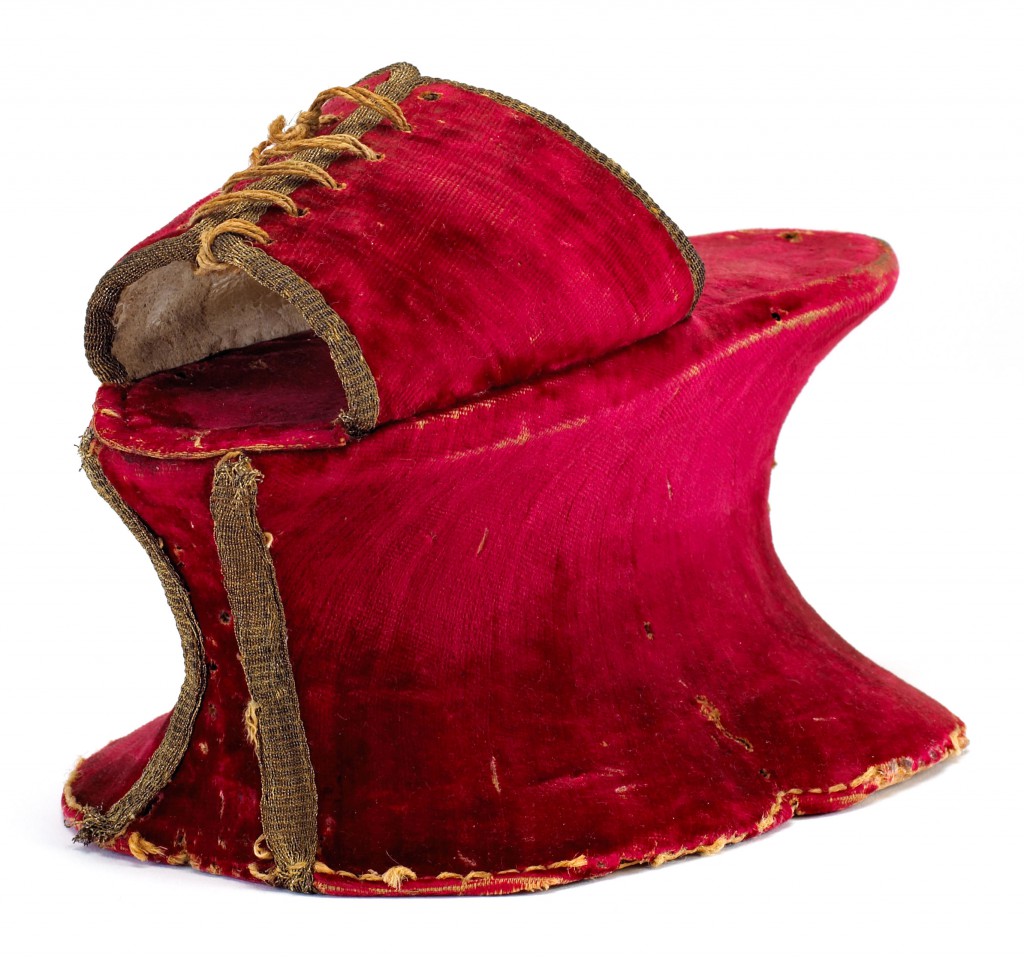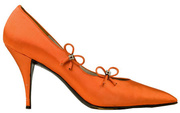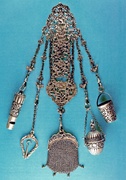
How far would you go to reach the pinnacle of fashion? While the current craze for heel-less, “anti-gravity” shoes might seem avant-garde, or even dangerous, women have worn challenging footwear for centuries. In fact, though most think Lady Gaga’s stilted look started the latest anti-gravity trend, the pop star’s precarious platforms were actually inspired by elaborate 16th-century chopines.
“They were beyond extravagant, and they weren’t for clumping in the mud.”
From the Chinese tradition of lotus shoes for bound feet to the 20th-century stiletto, fabulous footwear is often shaped by social convention, and the chopine was no exception. Nearly 500 years ago, these sky-high, geometric platforms were designed to showcase familial wealth in parts of Spain and Italy. (The trend was undone in the 17th century by a new fad for heels inspired by Persian riding boots for men.)
Elizabeth Semmelhack, senior curator at the Bata Shoe Museum in Toronto, says that chopines developed from ancient platform styles worn at least since the 6th Century BCE. “Platforms had this very long tradition in Europe up through the 17th century, and then they were out until the 20th century. Really, it wasn’t until Ferragamo reintroduced them in the 1930s that platforms came back in fashion.” In 2009, Semmelhack organized an exhibition and an accompanying catalog on the topic of these elevating shoes, titled “On A Pedestal: From Renaissance Chopines to Baroque Heels.”
We spoke with Semmelhack about the chopine’s unique place in sartorial history and the lengths (or heights) humans go to showcase their status.

Top: An extremely tall Venetian chopine made from wood covered in white leather with minimal ornamentation. Courtesy the Bata Shoe Museum. Above: A closer view of wooden Venetian chopines covered in leather, circa 1740s. Via the Museum of Fine Arts, Boston.
Collectors Weekly: When did women start wearing platforms?
Elizabeth Semmelhack: Although the chopine was a 16th-century form of footwear, it actually has classical antecedents. I traced the wearing of platform shoes back to Greece, and found a very long tradition in antiquity of women wearing this style of footwear. In fact, some images of Aphrodite show her in excessively high platforms. It remains unclear to me whether these images of Aphrodite in really high platforms were simply an artistic expression or if they reflect some kind of lived practice. There is no extant footwear from the Greek Isles or the Italian Peninsula during that era because conditions didn’t allowed them to survive.
“Men denounced women for putting on shoes of this height, but they were wearing these shoes to flaunt the wealth of their fathers or their husbands.”
The Romans were very influenced by Greek fashion, and Roman women also wore platform footwear of a modest height. When the Romans took over the Iberian Peninsula [where Spain is today], they started a cork shoemaking industry. Later, the Moors invaded the Iberian Peninsula and inherited this industry. So within Moorish Spain, they were making platform footwear that was exported across the Maghreb region. I’ve argued that this form of Moorish platform shoe became a luxury item that then was worn by Christian women.
Collectors Weekly: Where did chopines originate?
Semmelhack: Most people don’t realize that until very recently, the source of everything desirable in Western fashion was coming from the Near East, the Middle East, the Far East. It wasn’t intra-European. It was Europeans looking to the East. So these Moorish cork chopines were integrated into the Spanish Christian women’s wardrobe, and eventually, they became popular within the Italian peninsula.
The main characteristic that differentiated the two styles was that Spanish chopines were made of cork, while Italian chopines were made of wood. However, I’ve seen many Italian wooden chopines that have hybrid Spanish elements, suggesting that it really was a Spanish-to-Italian transfer of style. But the way they were worn in Spain and Italy was incredibly different.

This pair of chapins, the Spanish version of chopines, has cork platforms covered in elaborately tooled leather. Courtesy the Bata Shoe Museum.
Spanish women wore their skirts to the tops of their chopines. Since their chopines were always visible, they tended to be made from luxury materials, such as the highly worked and embossed leatherwork that Spain was famous for. Spanish women also tended to be fully cloaked in long black scarves. I believe the visibility of the chopine heightened interest in what a woman was wearing, suggesting that luxury fashions were hidden underneath her black mantle. In this way, expressions of status and socioeconomic power were given to their shoes, because the rest of a woman’s costume was hidden from view. Queen Isabella’s confessor famously said, “There’s not enough cork in all of Spain to meet the needs of women in regard to their chopines.”
In Venice, where the textile trade was the source of their economic power, Venetian women dressed in very tall, wooden chopines that were hidden by their dresses, thereby lengthening their skirts. They were never allowed to show their chopines, so the shoes became a means of displaying more textile wealth. Venetian chopines were worn more like undergarments or support garments. Spanish chopines were worn as actual accessories of dress.

This watercolor from 1540 shows Spanish women in pattens, platform shoes that preceded chopines and were originally worn over expensive shoes to protect them from street wear. Expensive platforms like these eventually became their own signifier of status. Via the Museo Stibbert, Florence.
Collectors Weekly: How did one move in chopines?
Semmelhack: It depends on the height of the shoe, but let’s imagine that we’re talking about Venetian chopines. It’s important to remember that Venetian upper-class women were sequestered and hidden from view most of the time, and only put on view certain times of the year. They never dressed themselves. Maybe they put their own clothes on, but they didn’t choose what to wear—the representational aspects of their dress were chosen for them.
Sometimes these women were put out like parade floats, mounted on very high chopines in splendid dresses. Their job was to convey the wealth of their families as well as the larger affluence of Venice. They had to walk very slowly and required the aid of two servants to navigate whatever space they were moving through, whether it was out in public or at a private evening with an ambassador from a foreign country, when women might be asked to do this kind of promenading.

This pair of Spanish chopines has a thick cork platform covered in silk damask, circa 1580-1620. Via the Victoria & Albert Museum, London.
There’s one rumor that I want to dispel, which is that chopines were worn to keep women up and out of the mud and muck. There is some truth to the fact that, in Spain, some unadorned platform shoes were worn by the peasantry to do exactly that. But the upper-class Spanish chopines were incredibly beautiful and covered in expensive leather or textile work. Sometimes they had diamonds and other fine gems attached to them. They were beyond extravagant, and they weren’t for clumping in the mud.
Venetian chopines were worn with a skirt completely covering them, so the shoes weren’t lifting a woman’s skirts out of anything. Plus, these skirts were so expensive that there’s no way they were dragging in the mud.

In the 16th century, upper-class Venetian women would have worn elegant chopines like this pair of velvet-covered shoes, which were explicitly designed as luxurious fashion (circa 1580-1620). Courtesy the Bata Shoe Museum.
Collectors Weekly: Were chopines limited to upper-class women?
Semmelhack: This is a complex question. During the 16th century, dowry inflation grew completely out of control, and it became prohibitively expensive to marry off one’s daughter. Venice was a republic and the ruling men of Venice all had to dress with a confraternal sameness, like when you go to Bay Street in Toronto [the financial district] and all the men are dressed the same. Because of that, women’s dress carried a greater burden of expressing individual family wealth. Marriages were an opportunity to show the wealth not only of the bride’s natal family but also of her nuptial family. By the end of the 16th century, the cost of weddings and all this costume became so prohibitive that wealthy families could only afford to marry one daughter per generation.
This resulted in a surplus of girls and boys who couldn’t find mates. Many girls were sent off to nunneries, and some boys were also sent off to join the church, but both state and church became concerned that men would turn to sodomy in order to satisfy their natural urges. In response, both church and state sanctioned what was called the “honest courtesan,” who behaved as an escort for upper-class men. A courtesan had access to the noble court and moved within that very high social circle. Courtesans were expected to dress like upper-class women, which meant they wore chopines.

This etching by Pietro Bertelli, called “Courtesan and Blind Cupid,” was made with a hinged dress that reveals a pair of Venetian undergarment-style chopines, circa 1588. Via the Metropolitan Museum of Art.
But a courtesan was not sequestered at home like true upper-class women: She could walk the streets. When visitors came to Venice and they saw these women walking around in chopines, they began to assume that chopines were only worn by courtesans, as opposed to the fact that courtesans were aping the dress of wealthy women. Were these honest courtesans upper class? They were of a different class. But they were wearing chopines because of this association, because of the particular social conditions from which the shoes emerged.
Collectors Weekly: Did less-affluent prostitutes also adopt chopines?
Semmelhack: Well, there’s a famous Caesare Vecellio woodblock print that shows a lower-class prostitute wearing a pair of chopines and her skirts are grazing the top of her shoes in a very Spanish manner. And if you read Vecellio’s text, he talks about how she basically cobbled together the classiest outfit she could based on what she could get her hands on, like a pair of discarded chopines and a second-hand skirt from somebody else. I’m still unraveling the relationship between prostitution and chopines, because it’s a bit more complex.

Though almost always hidden, Italian chopines were still made from elegant materials, like this red velvet style from the 16th century. Courtesy the Bata Shoe Museum.
Collectors Weekly: In Venice, was it provocative for a woman to reveal her shoes?
Semmelhack: Well, there were certainly texts that explained how women should sit and walk and dance without revealing their chopines. And the images where you do find chopines tend to be bawdy images, or images of women in states of undress. That’s one of the reasons I’ve also argued that they function more like underwear. Seeing any private aspects of female attire was provocative.

This etching by Cesare Vecellio shows a Venetian woman bleaching her hair on a balcony near a pair of chopines likely worn around the house, circa 1598.
Collectors Weekly: Did this impractical footwear inspire any controversy?
Semmelhack: Yes, chopines were criticized in a number of ways. Within Venice, typically these complaints had to do with fabric or textile consumption. People said that these really high chopines were forcing men to buy more fabric for these women’s skirts, and they wanted to stop this. That was one very strong criticism.
But the judgements often came from people living outside of Venice. Many critiques of the chopine came from English visitors or tourists from other cultures that didn’t wear chopines. They called these chopine-wearing women were “half wood, half woman,” and couldn’t understand why they would walk around like this.
They completely missed the social nuances—that “respectable” women were being put on view by their families for the expression of textile wealth, or that they were seeing “honest courstesans” who were dressed like upper class women.
The third criticism that you had in Spain as well as in Venice—and this is a very long-standing criticism about women—regarded their irrationality in relation to fashion. Men denounced women for putting on shoes of this height, but they were wearing these shoes to flaunt the wealth of their fathers or their husbands.
Collectors Weekly: Why did chopines go out of style?
Semmelhack: They went out of style due to the impact of world exploration. Venice had been a lynchpin between East and West, meaning that all of the desirable goods from the East had to come through Venice to enter Europe. After Portuguese explorers made it around the Horn of Africa and the Spanish “discovered” the New World, all of a sudden, Venice couldn’t hold on to its essential status. As further world exploration continued in the 16th century, there were new ways that gave people access to Near and Far Eastern goods, so Venice’s primary source of wealth was challenged.

By the late 17th century, men’s footwear incorporated heels drawn from Persian riding boots, like this boy’s boot with a stacked leather heel. Courtesy the Bata Shoe Museum.
The Venetian economic well-being loses momentum as you head into the 17th century. The center of fashion moves to France, and the court of Louis XIV set the trends of European fashion. The next form of footwear that came into Western dress was heeled footwear, which was adapted from the Near East at the turn of the 17th century. This style was related to equestrianism and military virility, and men are the first to adopt it.
There’s this very clear evidence of heel-wearing for horseback riding throughout the Near East. In Western Europe, heels show up around the same time that Shah Abbas of Persia was courting a number of European powers to rise up against the Ottoman Empire. Shah Abbas had the largest mounted of military in the world. I think it was the rise of Persia that made the heel all of sudden of interest to European men—it had nothing to do with the chopine.
But very soon after that initial adoption, women start wearing heels as well. They were the next big thing, worn by both men and women throughout the rest of the 17th century. The heel only becomes exclusive to women’s dress in the 1730s. And the chopine began to fade from view.
(To learn more about chopines, visit the Bata Shoe Museum.)

 The Killer Mobile Device for Victorian Women
The Killer Mobile Device for Victorian Women
 Sex, Power, and High Heels: An Interview with Shoe Curator Elizabeth Semmelhack
Sex, Power, and High Heels: An Interview with Shoe Curator Elizabeth Semmelhack The Killer Mobile Device for Victorian Women
The Killer Mobile Device for Victorian Women Flip-Flops in the Office: Tragedy or Triumph?
Flip-Flops in the Office: Tragedy or Triumph? Platform ShoesThe platform has had two major debuts in the world of women’s shoe fashions…
Platform ShoesThe platform has had two major debuts in the world of women’s shoe fashions… Womens Pre-1950s ShoesIn the early 1900s, a woman’s ankle was usually hidden from view by a long,…
Womens Pre-1950s ShoesIn the early 1900s, a woman’s ankle was usually hidden from view by a long,… Mari Tepper: Laying it on the Line
Mari Tepper: Laying it on the Line Nice Ice: Valerie Hammond on the Genteel Charm of Vintage Canadian Costume Jewelry
Nice Ice: Valerie Hammond on the Genteel Charm of Vintage Canadian Costume Jewelry How Jim Heimann Got Crazy for California Architecture
How Jim Heimann Got Crazy for California Architecture Modernist Man: Jock Peters May Be the Most Influential Architect You've Never Heard Of
Modernist Man: Jock Peters May Be the Most Influential Architect You've Never Heard Of Meet Cute: Were Kokeshi Dolls the Models for Hello Kitty, Pokemon, and Be@rbrick?
Meet Cute: Were Kokeshi Dolls the Models for Hello Kitty, Pokemon, and Be@rbrick? When the King of Comedy Posters Set His Surreal Sights on the World of Rock 'n' Roll
When the King of Comedy Posters Set His Surreal Sights on the World of Rock 'n' Roll How One Artist Makes New Art From Old Coloring Books and Found Photos
How One Artist Makes New Art From Old Coloring Books and Found Photos Say Cheese! How Bad Photography Has Changed Our Definition of Good Pictures
Say Cheese! How Bad Photography Has Changed Our Definition of Good Pictures Middle Earthenware: One Family's Quest to Reclaim Its Place in British Pottery History
Middle Earthenware: One Family's Quest to Reclaim Its Place in British Pottery History Fancy Fowl: How an Evil Sea Captain and a Beloved Queen Made the World Crave KFC
Fancy Fowl: How an Evil Sea Captain and a Beloved Queen Made the World Crave KFC
Great article- I’ve always been curious about the details of Renaissance era platforms. And now I wish I knew more about the process of bleaching hair in the illustration above!
Wonderful articles! Thank you so much for providing this history. There is so much to learn in this world and not enough time to read all the books in a library. These concise and interesting articles are a joy to read. Thank you so much for giving me a peek into history that is so enjoyable I just want to keep reading.
In which museum is the statute of Aphrodite (wearing chopines) located?